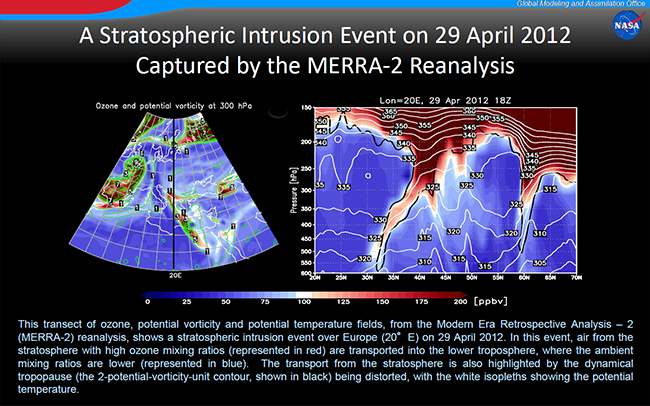A Stratospheric Intrusion Event on 29 April 2012 Captured by the MERRA-2 Reanalysis
The tropopause is the boundary that separates the bottom two layers of the atmosphere: the troposphere and the stratosphere. The former extends from the surface to about 8-12 km in the middle and high latitudes and up to 18 km in the tropics and exhibits very different dynamical behavior and chemical composition than the latter. For example, the total amount of ozone in the troposphere is an order of magnitude smaller than in the stratosphere despite much higher air density. Consequently, any process in which stratospheric air gets transported into the troposphere constitutes a non-negligible source of tropospheric ozone in addition to in-situ chemical production.
The tropopause height is highly variable in time, especially in the extratropics. In particular, upper-level baroclinic disturbances that develop in the vicinity of the jet streams sometimes result in intense tropopause folding events, in which tongs of stratospheric air penetrate downwards injecting large amounts of ozone into the troposphere. Such events are called stratospheric intrusions. Subsequent irreversible mixing results in elevated ozone concentrations, which in some cases can be detected even at the surface.
Thanks to the simultaneous assimilation of meteorological and ozone observations MERRA-2 is capable of reproducing large stratospheric intrusions such as the one that occurred over Europe on 29 April 2012. The map on the left shows potential vorticity (PV) and ozone concentrations at the 300 hPa level (~9 km above the surface). High PV contours, indicative of low tropopause, are closely aligned with elevated ozone, as expected. As seen in the right panel, a large tropopause fold extends down to ~600 hPa (~4.5 km) at 20°E between 30°N and 40°N. A tongue of high PV stratospheric air moves downward along highly inclined surfaces of constant potential temperature (white lines), consistent with adiabatic transport of ozone-rich stratospheric air into the middle troposphere.


